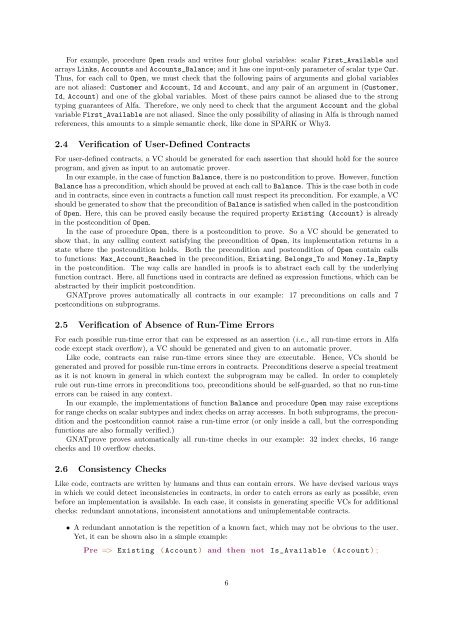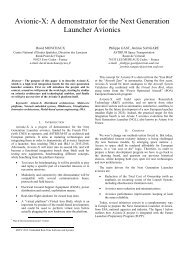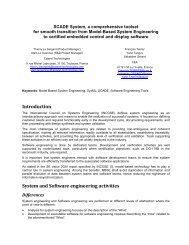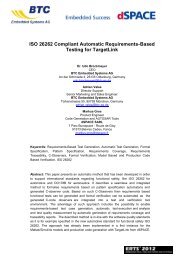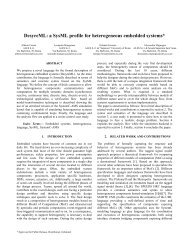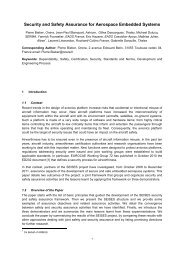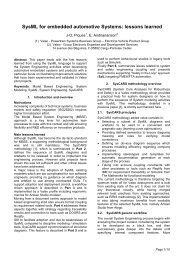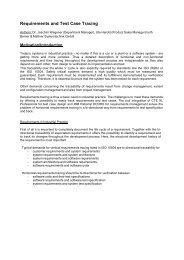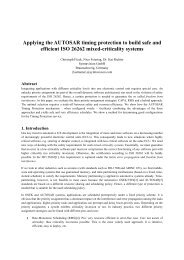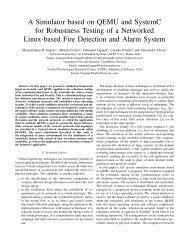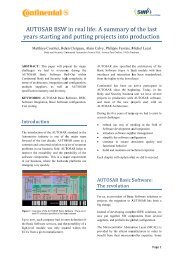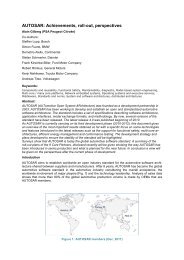Integrating Formal Program Verification with Testing
Integrating Formal Program Verification with Testing
Integrating Formal Program Verification with Testing
- No tags were found...
You also want an ePaper? Increase the reach of your titles
YUMPU automatically turns print PDFs into web optimized ePapers that Google loves.
For example, procedure Open reads and writes four global variables: scalar First_Available andarrays Links, Accounts and Accounts_Balance; and it has one input-only parameter of scalar type Cur.Thus, for each call to Open, we must check that the following pairs of arguments and global variablesare not aliased: Customer and Account, Id and Account, and any pair of an argument in (Customer,Id, Account) and one of the global variables. Most of these pairs cannot be aliased due to the strongtyping guarantees of Alfa. Therefore, we only need to check that the argument Account and the globalvariable First_Available are not aliased. Since the only possibility of aliasing in Alfa is through namedreferences, this amounts to a simple semantic check, like done in SPARK or Why3.2.4 <strong>Verification</strong> of User-Defined ContractsFor user-defined contracts, a VC should be generated for each assertion that should hold for the sourceprogram, and given as input to an automatic prover.In our example, in the case of function Balance, there is no postcondition to prove. However, functionBalance has a precondition, which should be proved at each call to Balance. This is the case both in codeand in contracts, since even in contracts a function call must respect its precondition. For example, a VCshould be generated to show that the precondition of Balance is satisfied when called in the postconditionof Open. Here, this can be proved easily because the required property Existing (Account) is alreadyin the postcondition of Open.In the case of procedure Open, there is a postcondition to prove. So a VC should be generated toshow that, in any calling context satisfying the precondition of Open, its implementation returns in astate where the postcondition holds. Both the precondition and postcondition of Open contain callsto functions: Max_Account_Reached in the precondition, Existing, Belongs_To and Money.Is_Emptyin the postcondition. The way calls are handled in proofs is to abstract each call by the underlyingfunction contract. Here, all functions used in contracts are defined as expression functions, which can beabstracted by their implicit postcondition.GNATprove proves automatically all contracts in our example: 17 preconditions on calls and 7postconditions on subprograms.2.5 <strong>Verification</strong> of Absence of Run-Time ErrorsFor each possible run-time error that can be expressed as an assertion (i.e., all run-time errors in Alfacode except stack overflow), a VC should be generated and given to an automatic prover.Like code, contracts can raise run-time errors since they are executable. Hence, VCs should begenerated and proved for possible run-time errors in contracts. Preconditions deserve a special treatmentas it is not known in general in which context the subprogram may be called. In order to completelyrule out run-time errors in preconditions too, preconditions should be self-guarded, so that no run-timeerrors can be raised in any context.In our example, the implementations of function Balance and procedure Open may raise exceptionsfor range checks on scalar subtypes and index checks on array accesses. In both subprograms, the preconditionand the postcondition cannot raise a run-time error (or only inside a call, but the correspondingfunctions are also formally verified.)GNATprove proves automatically all run-time checks in our example: 32 index checks, 16 rangechecks and 10 overflow checks.2.6 Consistency ChecksLike code, contracts are written by humans and thus can contain errors. We have devised various waysin which we could detect inconsistencies in contracts, in order to catch errors as early as possible, evenbefore an implementation is available. In each case, it consists in generating specific VCs for additionalchecks: redundant annotations, inconsistent annotations and unimplementable contracts.• A redundant annotation is the repetition of a known fact, which may not be obvious to the user.Yet, it can be shown also in a simple example:Pre => Existing ( Account ) and then not Is_Available ( Account ) ;6


